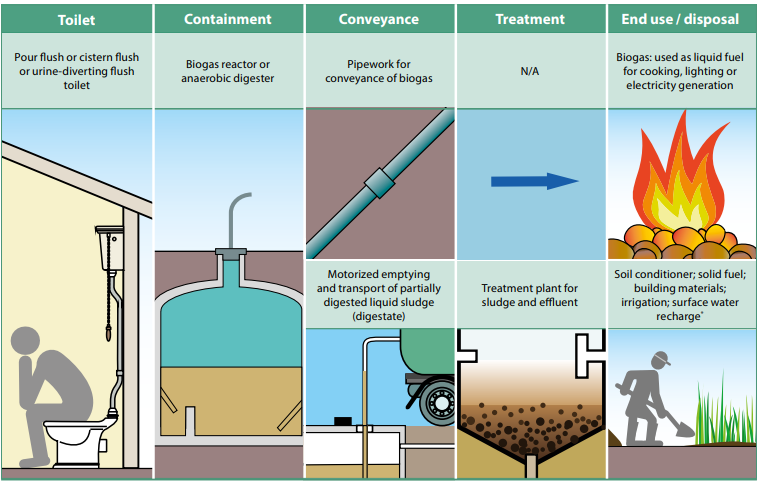Today, our guest blogger Frances Mak explores the molecular science and engineering of a side product from the waste water treatment processes: biomethane for clean energy.
When I think of clean energy, I often think of the one peculiar wind turbine in the heart of downtown Toronto, Canada. It stands alone, juxtaposed with the Toronto skyline at its back, with the sounds of cars from the nearby highway. I think most people think of wind turbines and solar panels when they think of clean energy. However, a green energy source I wasn’t so aware of is biomethane. The irony of this “cleaner” option is that biomethane starts with the messiest source: our waste.
Generating biogas, including biomethane
Biogas systems collect, store, and treat waste in order to convert it to energy. The waste collection stage can use various types of toilets, including pour-flush, cistern, and urine-diverting toilets. This toilet diversity is advantageous as it increases the amount of communities this system can connect to. Therefore, it is not necessary to change existing toilets for this specific system to work.
The storage stage involves digesters to generate usable biogas from the waste. Biogas consists of 60% methane (CH4), 40% carbon dioxide (CO2), and a small percentage of hydrogen sulphide (H2S). Specific microorganisms break down human waste products and release biogas. This breakdown is different from natural decomposition as it happens in the absence of oxygen (anaerobic digestion) and uses different types of microorganisms. Fungi are the most common decomposers in natural decomposition, while in anaerobic digestion, anaerobic bacteria and methanogenic archaea are used.
The first chemical process that occurs is hydrolysis and acidification. Large molecules (carbs, proteins, fats) are broken down into small organic molecules (sugars, amino acids, fatty acids.) Then, microbes called acetogens and methanogens are active in the next step. Acetogens initiate acetogenesis which takes organic acids and turns them into acetate. Methanogens drive methanogenesis to generate methane gas. The methane part of the biogas produced through this process can be purified further and used as a renewable energy source.

Purifying biomethane

Biomethane can be further separated from biogas. Biomethane has lower greenhouse gas emissions than other gas fuels. Therefore it is advantageous for biogas to undergo further treatment, using e.g. gas separation membranes and scrubbers. Gas separation membranes are responsible for removing carbon dioxide from biogas. It takes advantage of the partial pressures of the different gases and uses selective permeability to remove the carbon dioxide.
Sulphur dioxide pollution is produced when biogas is burned and it is very damaging to equipment, as it is corrosive. To avoid this, scrubbers are responsible for removing hydrogen sulphide beforehand. This is done by the injection of atmospheric air into scrubber tanks, allowing bacteria to effectively oxidize the sulphur dioxide. The end result is biomethane (96% methane, 3% carbon dioxide, 1% other), a clean energy source that is ready for use.
How green is biomethane?
Biogas and biomethane are (relatively) eco-friendly energy sources that are now being taken advantage of with the hopes of replacing gas from fossil fuels used for heating and transport.
The fact that biomethane is renewable makes a significant difference to its carbon footprint. Since it comes from organic sources, the CO2 released from its combustion is offset by carbon sequestration when feedstock is grown. Converting organic wastes into biogas also avoids another major contribution to greenhouse gas emissions: release of methane from natural organic decomposition. Effectively the methane is converted into CO2 before release. Because methane has much greater global warming potential than CO2, this is a step in the right direction.
Scaling up biogas use

In Vietnam, there was huge growth in their livestock industry which produced large amounts of manure. In order to avoid the negative ramifications of this sudden increase, waste management in the form of biogas digesters was put into action. The production of biogas was used as a replacement for liquified petroleum gas (LPG) in household appliances such as stoves. This eliminated the risk of indoor smoke inhalation that LPGs posed as well as simultaneously increasing the efficiency of waste disposal in the country.
On a larger scale, places such as Luxembourg, Switzerland and the UK have directly inserted biomethane into their natural gas grids. It is the primary strategy used to decarbonize the EU’s energy system, as it is a substitute for natural gases.
In Canada, there has been a similar focus, with provinces—British Columbia and Quebec—establishing policies that mandate distributors to supply a certain amount of biomethane in their gas grids. Who knows? The lonesome wind turbine in Toronto may yet have served as a potential idea spark for such advancements in the green energy sector.
The molecular science and engineering of Water, sanitation and hygiene (WASH) technologies
Find out more about how the molecular science and engineering approach is being used to tackle one of the great challenges of our time: delivering clean water and sanitation to all (UN Sustainable Development Goal 6). Read more here: